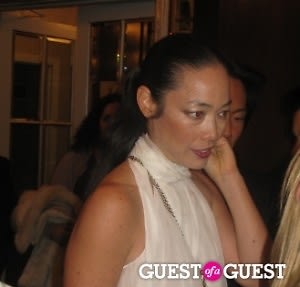 For magazines trying to stay afloat as the foreboding death knells of print resound, Visionaire may have the artefactual essence to grant it immunity. Cecilia Dean explained to us last night how her savvy, artistic magazine has been faring in the digital age.
For magazines trying to stay afloat as the foreboding death knells of print resound, Visionaire may have the artefactual essence to grant it immunity. Cecilia Dean explained to us last night how her savvy, artistic magazine has been faring in the digital age.
Since Visionaire's beginning--founded in 1991 by Dean, Stephen Gan, and James Kaliardos--the fashion/arts magazine has carved out a peculiar niche: an avant-garde bent that's snappy and new on the one hand and on the other, antiquated with each issue emerging as a certain objet d'art. Issues like "Scent" create an extraordinary compendium of a sensory experience with artists and performers creating their own fragrances and responding to them with words or images (an expansion on the mundane mag cologne advertisement). With V and VMAN within the Visionaire publishing roster, the unique publication seems to be thriving.
The Visionaire issue in the works, Fairy Tales, will feature eleven individual fable books by artists and go for $195. Contributors include John Baldessari, Karen Kilimnik with a story by Kirsten Dunst, and Bjork and Sjon with artist Gabriela Fridriksdottir. The previous issue had been a tribute issue to Alexander McQueen called Spirit which went for $300, a price that has been raised given the issue's rarity. Some back issues can go for several thousand dollars.
Visionaire manages to charge these prices at a time when people are refusing to subscribe to The New Yorker for peanuts.
"We're totally supportive of the whole online world and online magazines and things going digital," Dean said at the Waldorf Astoria for the 45th Annual Fashion Scholarship Awards. "And I think it's an incredible medium to access information instantaneously. And I think that puts the responsibility on magazines to maybe rethink their purpose, and I feel like in a funny way, Visionaire almost makes more sense in an online world than it did in an offline world, because it's all about the object and the experience and something that you can't actually do digitally or online. In a funny way, people are always talking about the death of print, the death of magazines, Visionaire has actually experienced the opposite."
Visionaire tends to print 4,000 copies of each issue, but that number can fluctuate. For a while, Visionaire did most of its sales through retail stores, but interestingly enough, now most of the buyers make purchases online. V and VMan have iPad applications, but Visionaire--though it has online companions--has flourished most in printed form.
The publication can buck the print trend by enhancing the quality and artistry of the physical object. This dialogue reminded me of the Times piece from last week that discussed a designer of custom book collections to make libraries--tangible, glue-and-paper book libraries--that focus on the aesthetics of covers to combat the e-books trajectory. Naturally Visionaire is sustainable against that with its focus on six or more senses.
"You can't really have a scent issue digitally," I said to Dean.
"Not yet," she responded with a smirk, acknowledging her peculiar safety.
"I think we're mainly driven by what we personally want to explore, whether that is a particular format or particular artist or medium," she said, "and obviously, we have to pay attention to what's going on in the rest of the world to see how we fit into that. You know, we don't strategize in that respect. We just do what we do."


.jpg)
.jpg)



.jpg)
.jpg)
.jpg)


.jpg)

.jpg)